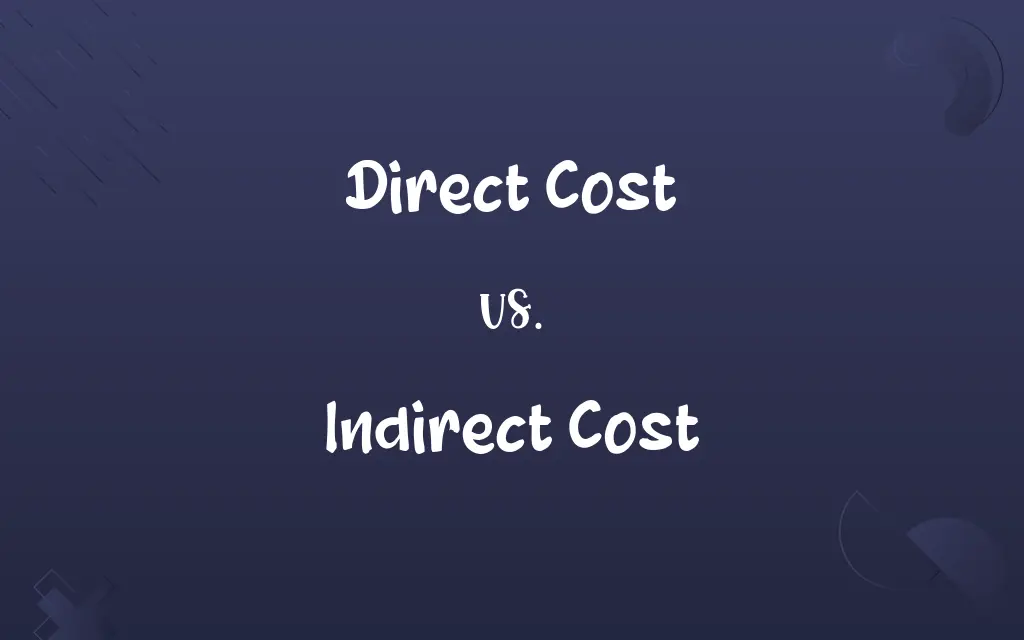Direct Cost vs. Indirect Cost: Know the Difference

By Shumaila Saeed || Published on January 25, 2024
Direct costs are expenses directly tied to a specific product or service, while indirect costs are general business expenses not directly linked to any specific product or service.

Key Differences
Direct Costs are expenses that can be directly attributed to a specific product, service, or project. They include materials, labor, and expenses that are directly involved in the production. Indirect Costs, also known as overheads, are expenses not directly tied to a specific product or service, such as rent, utilities, and administrative salaries.
Shumaila Saeed
Jan 25, 2024
Direct Costs are easily traceable to a particular cost object, like a unit of product. Examples include the cost of raw materials and wages for labor directly involved in production. Indirect Costs cannot be traced back to a specific cost object easily. They are often spread across multiple products or services, like maintenance costs or office supplies.
Shumaila Saeed
Jan 25, 2024
In accounting, Direct Costs are crucial for determining the exact cost of manufacturing a product or providing a service. They affect the gross profit margin and are variable in nature. Indirect Costs are more associated with the day-to-day running of a business and are usually fixed costs, not varying significantly with the level of production or sales.
Shumaila Saeed
Jan 25, 2024
When pricing products or services, Direct Costs are considered to calculate the cost of goods sold (COGS). They directly impact the profitability of each item sold. Indirect Costs, while necessary for overall business operations, do not directly influence the cost of individual products and are often allocated proportionally across all products or services.
Shumaila Saeed
Jan 25, 2024
Direct Costs are critical for short-term financial decisions and cost-control measures. They can be scaled up or down based on production needs. Indirect Costs often require long-term planning and budgeting as they are less flexible and not directly tied to production or sales activities.
Shumaila Saeed
Jan 25, 2024
ADVERTISEMENT
Comparison Chart
Traceability
Directly traceable to a product/service
Not directly traceable to a specific product/service
Shumaila Saeed
Jan 25, 2024
Examples
Raw materials, direct labor
Rent, utilities, administrative expenses
Shumaila Saeed
Jan 25, 2024
Impact on Pricing
Directly affects product pricing
Allocated across all products/services
Shumaila Saeed
Jan 25, 2024
Control
More easily controlled and adjusted
Less flexible, often fixed in the short term
Shumaila Saeed
Jan 25, 2024
ADVERTISEMENT
Direct Cost and Indirect Cost Definitions
Direct Cost
Direct cost is an expense directly attributed to the production of a specific product or service.
The cost of wood for a furniture manufacturer is a direct cost.
Shumaila Saeed
Jan 08, 2024
Indirect Cost
Indirect cost includes general business expenses like utilities, rent, and administrative salaries.
The salary of a company's CEO is an indirect cost.
Shumaila Saeed
Jan 08, 2024
Direct Cost
Direct cost is an expense that varies with the level of output or production.
The cost of ingredients for a bakery's bread is a direct cost.
Shumaila Saeed
Jan 08, 2024
Indirect Cost
In business, indirect cost is a necessary expenditure that supports multiple activities but cannot be assigned to one specific product or service.
The cost of cleaning services for an office building is an indirect cost.
Shumaila Saeed
Jan 08, 2024
Direct Cost
Direct cost includes any cost that can be specifically identified with a particular final cost objective.
The cost of a specific software license for a client project is a direct cost.
Shumaila Saeed
Jan 08, 2024
ADVERTISEMENT
Indirect Cost
Indirect cost is often a fixed expense that does not vary significantly with production levels.
Insurance premiums for a manufacturing plant are an indirect cost.
Shumaila Saeed
Jan 08, 2024
Direct Cost
In manufacturing, direct cost encompasses the raw materials and labor used in production.
The cost of steel for making cars is a direct cost for an automobile manufacturer.
Shumaila Saeed
Jan 08, 2024
Indirect Cost
Indirect cost encompasses overhead expenses required for a business to function but not directly tied to any specific business activity.
The cost of software used company-wide is an indirect cost.
Shumaila Saeed
Jan 08, 2024
Direct Cost
Direct cost refers to expenses that can be directly linked to a specific project.
Wages for laborers working on a construction project are direct costs.
Shumaila Saeed
Jan 08, 2024
Indirect Cost
Indirect cost refers to expenses that are not directly linked to a specific product, service, or project.
The rent for a factory where multiple products are made is an indirect cost.
Shumaila Saeed
Jan 08, 2024
Repeatedly Asked Queries
Can a cost be both direct and indirect?
No, a cost is either direct or indirect based on its relation to a product or service.
Shumaila Saeed
Jan 25, 2024
How do direct costs affect pricing?
Direct costs directly influence the pricing of products or services.
Shumaila Saeed
Jan 25, 2024
Are indirect costs included in the cost of goods sold?
No, indirect costs are not part of the cost of goods sold (COGS).
Shumaila Saeed
Jan 25, 2024
How are direct costs recorded in accounting?
Direct costs are recorded as expenses directly associated with the production of goods or services.
Shumaila Saeed
Jan 25, 2024
What is a direct cost?
A direct cost is an expense directly attributable to the production of a specific product or service.
Shumaila Saeed
Jan 25, 2024
Do indirect costs vary with production volume?
Indirect costs are typically fixed and do not vary significantly with production volume.
Shumaila Saeed
Jan 25, 2024
What is an indirect cost?
An indirect cost is a general business expense not directly linked to a specific product or service.
Shumaila Saeed
Jan 25, 2024
Are direct costs variable or fixed?
Direct costs are typically variable, changing with the level of production.
Shumaila Saeed
Jan 25, 2024
Can direct costs be controlled more easily than indirect costs?
Yes, direct costs are typically more controllable as they are directly tied to production.
Shumaila Saeed
Jan 25, 2024
Why are indirect costs sometimes called overheads?
Indirect costs are called overheads because they cover the general operating expenses of a business.
Shumaila Saeed
Jan 25, 2024
How do service industries categorize direct costs?
In service industries, direct costs include labor and materials specifically for a service.
Shumaila Saeed
Jan 25, 2024
Can indirect costs affect profitability?
Yes, high indirect costs can significantly impact overall profitability.
Shumaila Saeed
Jan 25, 2024
How do businesses budget for indirect costs?
Businesses budget for indirect costs based on historical data and projected needs.
Shumaila Saeed
Jan 25, 2024
Is depreciation a direct or indirect cost?
Depreciation is usually an indirect cost.
Shumaila Saeed
Jan 25, 2024
Why are indirect costs important?
Indirect costs are crucial for understanding the overall expenses of running a business.
Shumaila Saeed
Jan 25, 2024
Can indirect costs be allocated to products?
Yes, indirect costs are often allocated across products or services proportionally.
Shumaila Saeed
Jan 25, 2024
What is an example of a direct cost in manufacturing?
An example is the cost of raw materials used in producing a product.
Shumaila Saeed
Jan 25, 2024
Is employee training a direct or indirect cost?
Employee training is generally an indirect cost unless it's for a specific project.
Shumaila Saeed
Jan 25, 2024
Are marketing expenses direct or indirect costs?
Marketing expenses are usually considered indirect costs.
Shumaila Saeed
Jan 25, 2024
Are direct costs important for break-even analysis?
Yes, direct costs are crucial in determining the break-even point for a product or service.
Shumaila Saeed
Jan 25, 2024
Share this page
Link for your blog / website
HTML
Link to share via messenger
About Author
Written by
Shumaila SaeedShumaila Saeed, an expert content creator with 6 years of experience, specializes in distilling complex topics into easily digestible comparisons, shining a light on the nuances that both inform and educate readers with clarity and accuracy.









































































